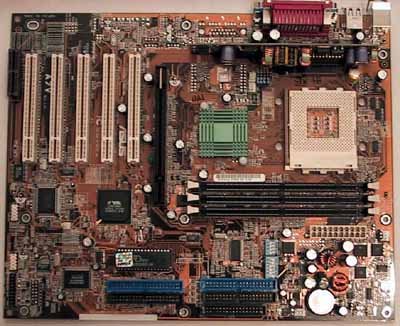
Original Link: https://www.anandtech.com/show/606
ASUS A7V Socket-A KT133 ATX
by Anand Lal Shimpi on August 22, 2000 12:00 PM EST- Posted in
- Motherboards
ASUS has always been one of the most solid and well-respected motherboard manufacturers in the industry. On our first trip to Taipei, Taiwan for this year's Computex 2000, we were amazed at the respect ASUS was given, even by competing motherboard manufacturers. Unlike other markets that we are report on, there seems to be much less bashing of competing companies in the motherboard industry, and more competition based solely on the merits of a company's products.
ASUS has attained this high level of respect by consistently delivering some of the most reliable, high performing and flexible motherboard designs we have ever seen. Case in point would be one of ASUS' most recent entries into the motherboard market, the i815E based CUSL2. An instant winner in our eyes, the CUSL2 took the same chipset that every other motherboard manufacturer was equipped with, and managed to produce a motherboard that was more impressive than any other design based on that chipset.
Another example of the ASUS standard would be their K7M, quite possibly the most highly anticipated motherboard for the Athlon processor. If you remember, the release of the K7M wasn't as clean cut as most of ASUS' earlier motherboard launches, simply because the company's close ties to Intel made releasing an AMD 750 based motherboard for use with the AMD Athlon far from the best way to maintain a healthy relationship with Intel. After a bit of toying around with ways to lessen their involvement with the production of the K7M, ASUS eventually rose to the point where they came out and fully supported the motherboard. The K7M turned out to be the most mature AMD 750 board in a time when finding a solid Athlon motherboard was quite difficult. Once again, ASUS was armed with the same chipset as everyone else, but they were simply able to produce a better implementation than the competition. Any company can copy a reference design; a good manufacturer improves upon it.
Since their cautious entry into the Athlon motherboard market, ASUS has become much more comfortable with releasing boards that support AMD's flagship. After the K7M, their KX133-based K7V (and the microATX version, the K7V-RM) hit the streets and proudly bore the ASUS name, as it became one of our two favorite KX133 based motherboards. This time around, armed with a new CPU interface to support, the 462-pin Socket-A, and a somewhat "new" chipset, VIA's KT133, ASUS is back once again to provide AMD's fastest processors a place they can call home.
We call it, the ASUS A7V.
|
ASUS A7V |
|
|
CPU
Interface
|
Socket-A
|
|
Chipset
|
VIA
KT133
|
|
Form
Factor
|
ATX
|
|
Bus
Speeds
|
90/95/100/101/102/103/105/107/109/110/111/113
115/117/120/125/130/133/135/137 139/140/143/145MHz |
|
Voltages
Supported
|
1.30 - 1.85V in 0.05V increments
|
|
Memory
Slots
|
3
168-pin DIMM Slots
|
|
Expansion
Slots
|
1 AGP Slot
5 PCI Slots (3 Full Length) 0 ISA Slots 1 AMR Slot |
|
On-board
Audio
|
Cirrus
Logic CrystalClearSoundFusion CS4299 AC'97
|
|
BIOS
|
Award
Medallion BIOS 6.00
|
The Good
Like its closest competitor, the ASUS A7V starts off with a fairly hefty PCB. In terms of size, it is comparable to the older ASUS K7V, AOpen AK72, EPoX 7KXA, and Tyan Trinity K7 boards. When compared to the ABIT KT7, the ASUS A7V has a much "cleaner" layout, mainly because of the vertically mounted daughterboard that contains quite a few of the capacitors and power regulators that would normally be positioned around the CPU socket.
While it is difficult to say exactly why ASUS chose to mount these components vertically, there are a number of possibilities that could hold true. We have yet to see ASUS do something that didn't have a very good reason behind it, so we're going to give them the benefit of the doubt and assume that their engineers know what they're doing. Possible explanations that we have come up with include that the move from a Slot-A based Athlon to a Socket-A based Thunderbird/Duron platform yielded slight differences in the trace length requirements for various components, and thus it made the most sense for ASUS to proceed with a layout that the A7V uses. The thought of an upgradeable VRM module had come to mind upon first seeing the A7V, especially with the power needs of the higher clocked Socket-A processors rising dramatically. If need be, ASUS could theoretically easily replace the VRM module (it's not plugged into a socket, so you would have to de-solder the connections before removing the board) with a quick RMA back to the factory, but then again, we're not sure if this was what ASUS had in mind.
The inclusion of this vertically mounted VRM module as well as the orientation of the CPU socket make the A7V very friendly towards the larger heatsinks that are becoming necessary as the higher clock speed Socket-A CPUs are producing quite a bit of heat (already at over 55W at 1GHz). The only potential problem is that there is a single Sanyo capacitor that is pretty close to the top right corner of the CPU socket, so before you drop $50 on that extreme cooler, you'll want to make sure it can clear that capacitor. All standard heatsink/fan combos will work fine on the board since it does comply with AMD's specifications.
The A7V's "clean" layout continues as the VIA 371 North Bridge is positioned almost perfectly between the AGP Pro50 slot and the CPU Socket. Unfortunately, the results of this "clean" layout are seen in the fact that the ATX power connector does not have as prime of a location as it does on the ABIT KT7-RAID. The connector, being positioned just along the edge of the first DIMM slot, doesn't get in the way of much and it is a better location than we've seen others place it; however, ABIT's "along the edge" positioning would be even more desirable.
As we continue the comparison to the KT7-RAID, the heatsink on the VIA 731 North Bridge isn't actively cooled like that on the ABIT board, which is fine, since we saw no need for it, at the same time, there is no thermal compound placed between the North Bridge and the heatsink itself to aid in transferring heat. We haven't seen an immediate need for including thermal compound in this location and it doesn't affect stability as far as we know, so we didn't count against ASUS for not including it.
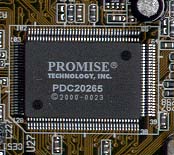 Following
a recent trend that we've seen with motherboards, the ASUS A7V is equipped with
the Promise 20265 Ultra ATA/100 controller. This controller adds two ATA/100
channels that complement the VIA 686A's two ATA/66/33 channels that are already
on the board. While the controller doesn't boast support for IDE
RAID, it is still nice to see that ASUS included support for it on the board.
The Promise controller is a departure from the first ATA/100 controller we saw
on an ASUS motherboard, which was the CMD 648 controller that was present on
the ASUS
CUBX. There currently isn't a need for ATA/100 support, but
if you plan on keeping your motherboard for a decent amount of time, the ATA/100
support could come in handy as drive speeds get faster and begin to burst at
speeds noticeably greater than 66MB/s. Also keep in mind that there isn't an
IDE drive currently available that achieves a sustained transfer rate of greater
than 40MB/s; this is far from the 66MB/s limit of the ATA/66 specification but
you have to remember that technology is constantly improving. It won't be too
long before we see the limits of ATA/66 reached.
Following
a recent trend that we've seen with motherboards, the ASUS A7V is equipped with
the Promise 20265 Ultra ATA/100 controller. This controller adds two ATA/100
channels that complement the VIA 686A's two ATA/66/33 channels that are already
on the board. While the controller doesn't boast support for IDE
RAID, it is still nice to see that ASUS included support for it on the board.
The Promise controller is a departure from the first ATA/100 controller we saw
on an ASUS motherboard, which was the CMD 648 controller that was present on
the ASUS
CUBX. There currently isn't a need for ATA/100 support, but
if you plan on keeping your motherboard for a decent amount of time, the ATA/100
support could come in handy as drive speeds get faster and begin to burst at
speeds noticeably greater than 66MB/s. Also keep in mind that there isn't an
IDE drive currently available that achieves a sustained transfer rate of greater
than 40MB/s; this is far from the 66MB/s limit of the ATA/66 specification but
you have to remember that technology is constantly improving. It won't be too
long before we see the limits of ATA/66 reached.
From an expansion slot perspective, ASUS is obviously much more OEM oriented than ABIT, who refrained from including anything outside of 6 PCI slots, an AGP slot and a shared ISA slot on their KT7-RAID. Reflecting this, the A7V features 5 PCI slots, an AGP Pro50 slot, and a AMR slot that is driven by the VIA 686A South Bridge and the on-board Cirrus Logic CrystalClearSoundFusion CS4299 AC'97 codec. The on-board AC'97 codec is actually used to drive the on-board audio I/O ports, leaving the AMR slot to be used for any modems that OEMs and system integrators may choose to install in the slot.
Just as with the CUSL2, ASUS decided that the A7V needed more USB ports (probably because it doesn't cost much to add this feature), so they threw in an optional Alcor Micro AU9254 USB Hub that brings the total USB count up to seven. It's basically a single chip generic USB hub, so there are no drivers to worry about and it should work under any OS that supports USB.
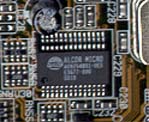
Unlike many manufacturers, ASUS actually includes the necessary header to take advantage of additional USB ports. Unfortunately, the header ASUS that includes only supports 3 additional ports, so two remain unused.
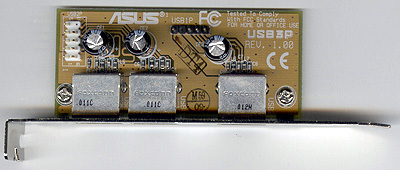
Just like the rest of the Socket-A motherboards we have seen thus far, the ASUS A7V features three DIMM slots capable of putting together a total of 1.5GB of PC133 or VC133 SDRAM. For those of you that are interested in taking the Socket-A Athlon (Thunderbird) and placing it in a high-end environment, this memory limit, provided that you can get high quality 512MB DIMMs, should be enough for most needs.
Just as with the CUSL2, the A7V features the Award Medallion BIOS (v6.00), which closely resembles an old Phoenix BIOS setup, except it has more performance tweaking features. The BIOS setup isn't quite as thorough as that on the KT7-RAID, but it is still a step ahead of the competition. However, one thing we can say about the A7V's BIOS is that when it comes to BIOS support, ASUS is quite possibly the best manufacturer, with constant BIOS updates and betas available seemingly every week. In the past, they've continued that support with fixes and new features even after the board has been discontinued.
ASUS' JumperFree CPU setup is once again present under the "Advanced" menu in the BIOS setup. This allows for the adjustment of the board's FSB frequency and the voltage supplied to the CPU. The supported FSB frequencies is extensive in spite of the fact that only a handful are even viable options; the only complaint we had was that the A7V currently can't supply more than 1.85v to the CPU. While most overclockers will be satisfied with that limit, there may be certain cases where you need the slight boost above 1.85v, and it isn't that hard for ASUS to instruct the A7V to supply more than that to the CPU. ABIT offers settings up to 2.05v on the KT7, so it shouldn't be that hard for ASUS to do the same with a simple BIOS update.
The board does feature I/O voltage control like most of ASUS' newer boards; the available options are 3.31v, 3.4v and 3.56, with the default being 3.4.
The other big feature of the A7V is that the later revisions of the board feature multiplier control via a set of dipswitches present by the ATA/66 channels. These dipswitches can help you unlock the clock multiplier of your Socket-A CPU provided that the "Golden Bridges" present at L1 on the chip itself are all connected. For more information on what this means and how to accomplish it, visit our ABIT KT7-RAID review, our KT133 Motherboard Roundup and our Thunderbird/Duron Overclocking Article.
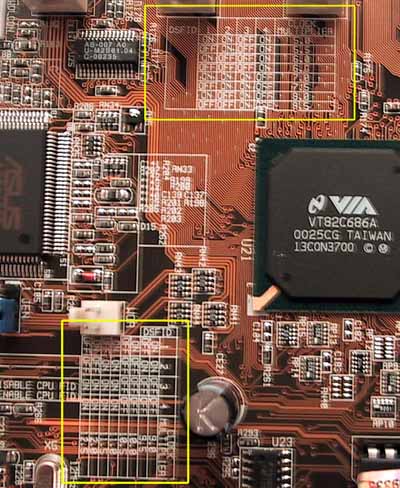
Multiplier dip-switch settings documented on the board itself
The stability of the A7V was definitely on-par with that of the ABIT KT7-RAID, which came out on top of our stability tests in the August 2000 KT133 Motherboard Roundup. This is what we've come to expect from ASUS and we are pleased to see this stability run continue with their latest entry into the motherboard market.
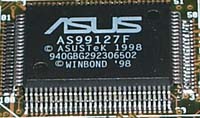 As
with previous ASUS boards, hardware monitoring is provided by a custom ASUS
AS99127F ASIC that can monitor 3 temperatures, 3 fan speeds, and 6 voltages.
And we can't forget to mention ASUS' very thorough and very easy-to-use manual
that continues yet another tradition of unparalleled quality from ASUS.
As
with previous ASUS boards, hardware monitoring is provided by a custom ASUS
AS99127F ASIC that can monitor 3 temperatures, 3 fan speeds, and 6 voltages.
And we can't forget to mention ASUS' very thorough and very easy-to-use manual
that continues yet another tradition of unparalleled quality from ASUS.
The Bad
We had very few complaints about the A7V; the biggest of those that did exist were concerning the lack of voltages higher than 1.85v, the positioning of the ATX power connector and last, but definitely not least, the fact that the A7V's JumperFree setup does not allow for clock multiplier adjustment and all multiplier manipulations must be performed on the board itself using a set of dip-switches.
USB Compatibility
-
Number of Front Universal Serial Bus Root Ports: 2
-
Number of Rear Universal Serial Bus Root Ports: 2
-
USB IRQ Enable/Disable in BIOS: Yes
-
USB Keyboard Support in BIOS: Yes
Recommended SDRAM
Recommended SDRAM: 1 x 128MB Corsair PC133 SDRAM; 1 x 128MB Mushkin PC133 SDRAM
SDRAM Tested: 1 x 128MB Corsair PC133 SDRAM; 1 x 128MB Mushkin PC133 SDRAM
Manufacturer:
Corsair
Purchase Website: http://www.corsairmicro.com
Manufacturer:
Mushkin
Purchase Website: http://www.mushkin.com
The Test
In recent times, choosing a motherboard cannot be completely determined by a Winstone score. Now, many boards come within one Winstone point of each other and therefore the need to benchmark boards against each other falls. Therefore you shouldn't base your decision entirely on the benchmarks you see here, but also on the technical features and advantages of this particular board, seeing as that will probably make the greatest difference in your overall experience.
Click Here to learn about AnandTech's Motherboard Testing Methodology.
|
Test Configuration |
|
| Processor(s): |
AMD
Athlon (Thunderbird) 1GHz
|
| RAM: | |
| Hard Drive(s): |
Western Digital 153BA Ultra
ATA 66 7200 RPM
|
| Bus Master Drivers: |
VIA Bus Master Drivers 2.1.47
|
| Video Card(s): |
NVIDIA
GeForce 256 SDR
|
| Video Drivers: |
NVIDIA
Detonator 5.22
|
| Operation System(s): |
Windows
98 SE
|
| Motherboard Revision: |
ASUS
A7V Revision 1.01
|
For more information click here to read our August 2000 Socket-A Motherboard Roundup

In Quake III the range of scores is much closer than you'd expect, we're definitely dealing with an overall mature group of boards.

The ABIT KT7-RAID pulls ever so slightly ahead of the competition, with ASUS & FIC following closely behind. All of the boards were pretty much in line with one another with the exception of the KV200-R which seemed to have some sort of performance problems. We're still trying to figure out the exact culprit of the board's sub-par performance.

This is an interesting situation, no manufacturer is able to keep up with the performance of VIA's reference board, although the FIC AZ-11 comes the closest.
Final Words
ASUS has impressed us yet again with the A7V, but it seems like this round is won by ABIT, mostly because of the features that their KT7-RAID offers mimic those of the A7V, as well as extend beyond what ASUS has chose to present with this board.
In spite of our preference for the KT7-RAID over the A7V, they are both equally capable motherboards, and you'll definitely be happy with either one. In the end it comes down to whether you need the ISA slot that's on the KT7, the RAID support on the KT7-RAID, and value the jumperless nature of the board's SoftMenu III setup or prefer the ASUS name, appreciate having 7 USB ports and like the somewhat lower price of the board since we have noticed that the ABIT boards are currently being priced fairly high.
In any case, if you go with the ABIT KT7-RAID or the ASUS A7V, you're not going to regret it, it all comes down to the little features to determine which board is better suited for your needs.
| Search for the lowest prices on the ASUS A7V |
How it Rates
|
AnandTech Motherboard Rating |
|
|
Rating (x/10)
|
|
|
Performance
|
7.5
|
|
Price
|
4.5
|
|
Stability
|
8.0
|
|
Quality
|
9.0
|
|
Features
|
7.5
|
|
Layout
|
6.5
|
|
Availability
|
7.0
|
|
Documentation & Software Bundle
|
7.5
|
| Overall Rating - not an average Click here to find out why |
8.5
|

